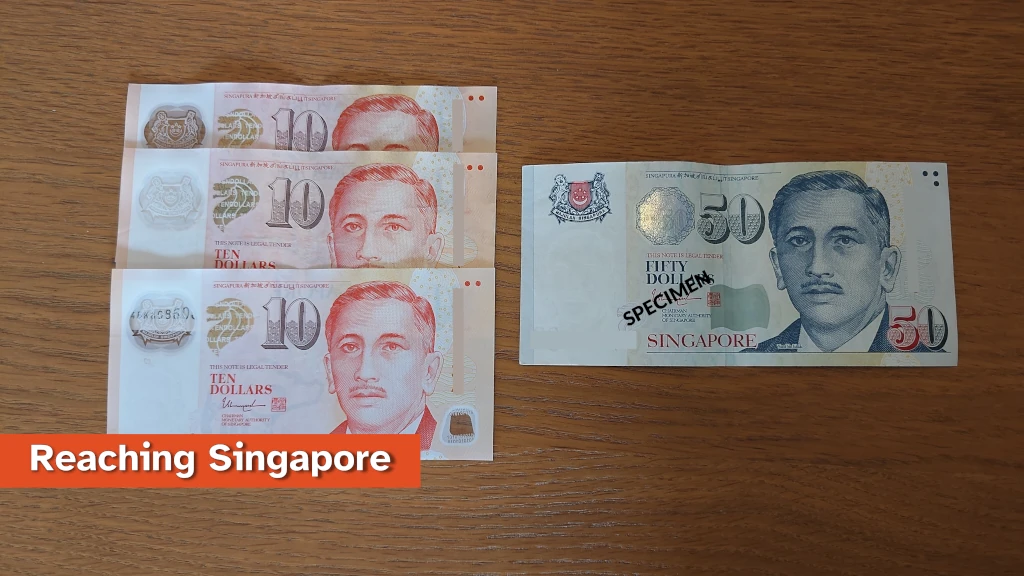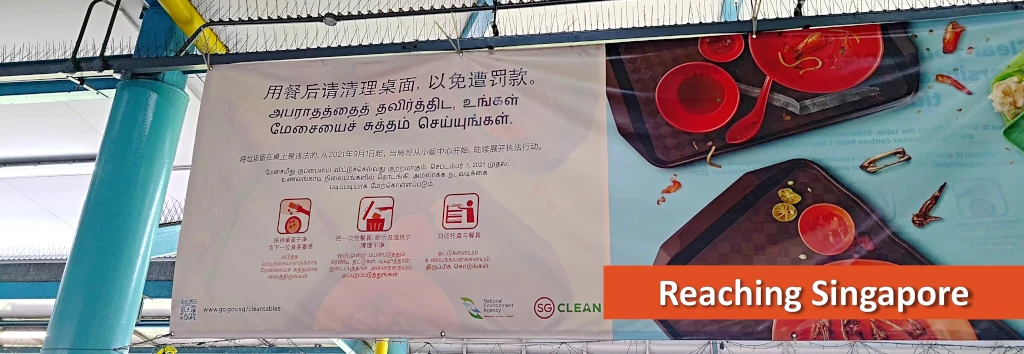20 Must Knows Before Visiting Singapore (start here)
I put this together as a comprehensive guide covering all the basics you need to know when you visit Singapore. This guide is designed for tourists and short-term visitors to Singapore.
1. Currency is Singapore Dollar
The Singapore Dollar is the currency used in Singapore. It is issued by the Monetary Authority of Singapore.
Symbols used for Singapore dollar include “SGD” and “S$”, though often in-country you’ll find simply “$” used everywhere. I use “S$” on all my guides to clarify that I’m talking about Singapore dollars instead of US dollars.
Notes come in S$2, S$10, S$50, and S$100. There used to also be S$1,000 and S$10,000 notes but these have been discontinued; they can still be used but the bank won’t give you new ones.

I have a whole guide on how much cash I recommend tourists carry in Singapore (as not all shops take credit card, particularly at hawker centres), check it out here: reachingsingapore.com/how-much-cash-singapore
Coins come in 5c, 10c, 20c, 50c, and S$1. There are two sizes of each coin in circulation, so you might be given two different sized coins for the same value. The 5c coin is not often used, many stalls will be unhappy about receiving it.
To get rid of Singaporean coins, hawker stalls and coffee shops will gladly accept payment in coins (except 5 cents) as this saves them a lot of trouble. There are a few other ways, including donation boxes at Changi Airport.
Did you know: Singapore Dollars are interchangeable with Brunei Dollars. The currencies are 1:1 and notes from one country are supposed to be accepted as legal tender in the other country. From my experience though it’s best to ask first as not all shop keepers or taxi drivers will be happy about receiving notes from the other country.
2. Plug sockets are Type G
When visiting Singapore, expect to use the same plug socket type (Type G) as the UK, Hong Kong, and Malaysia. The smaller Type C (2.5A rated) European plug is also accepted for use in Singapore.
As most outlets are Type G, it is difficult to squeeze a Type C cable in, though many Singaporeans will still try.

Ratings for your electronics should accept 230V at 50Hz. Most electronics these days - including phone chargers and laptops - works at this voltage.
Power outlets are generally NOT available in bathrooms in Singapore due to local safety regulations. Hotels in Singapore may often place the hair dryer outside the bathroom as Singaporeans do not expect to dry their hair inside the bathroom.
3. Mobile phone 4G and 5G is available
There are four primary networks in Singapore:
| Network | 4G | 5G |
|---|---|---|
| Singtel | YES | YES |
| Starhub | YES | YES |
| M1 | YES | YES |
| SIMBA | YES | YES |
Most 4G and 5G phones from overseas will work in Singapore, though if you are concerned I’ve found this reference helpful for figuring out if yours will work. For most networks, 3G will be phased out in 2024.
Coverage for each network is generally island-wide, though there may be some blackspots in the less populated areas. I’ve never found this a problem for tourists, even in ‘rural’ areas such as Mandai (where the wildlife attractions are). Congestion during peak hour, particularly on the MRT, may also mean your speed isn’t the best (though I’ve found Singapore mobile phone network coverage and speeds to be excellent regardless).
Other providers are available though these are re-sellers of the four primary networks. I usually recommend tourists buy one of the following SIM cards:
- Singtel S$8 or S$15 (depending on availability)
- Starhub S$8 or S$15
- SIMBA S$10 (includes roaming, so can be great if you’re going to another SE-Asia country afterwards)
I don’t usually recommend tourists buy the tourist SIM cards at Changi Airport as it is overkill for most visitor’s needs. I usually recommend buying a SIM card from a convenience store instead.
4. Emergency contact numbers
When I first came to Singapore I found the emergency contact numbers slightly different than those in other countries I’d visited, so please remember these in case you need them (hopefully you never do).
The official emergency contact numbers in Singapore can be found on the Gov.sg website here.
| Service | Number |
|---|---|
| Police | 999 |
| Fire | 995 |
| Ambulance | 995 |
| Police (emergency SMS) | 71999 |
| Non-Emergency Ambulance | 1777 |
The international GSM emergency number 112 should work in Singapore (it should redirect to 999), and it is marked on the national numbering plan as a reserved number - however no guarantees, best stick to a 999 or 995.
5. Other useful phone numbers
Other useful phone numbers that you might need during your visit to Singapore include:
| Service | Number |
|---|---|
| Taxi booking (common hotline) | +65 6342 5222 |
| Singapore General Hospital (enquiry, non-emergency) | +65 6222 3322 |
| Tourist Hotline | +65 6736 2000 |
| Singapore Airlines | +65 6223 8888 |
| Weather hotline | +65 6542 7788 |
The Tourist Hotline also has a chat bot on their website here that seems helpful. They do also have a toll-free number (1800 736 2000), but I’ve found this really only works best on landline phones.
6. Major holidays
While there are a few public holidays spread out throughout the year in Singapore (full list here), but these are the major ones celebrated across the city:
- Christmas - not as big as western countries, but still celebrated
- Deepavali - the most important festival in the Hindu calendar, and a significant festival for the Indian community in Singapore
- Hari Raya Puasa - also known as Eid Ul Fitr, celebrated by Muslims at the end of their fasting period
- Chinese New Year - taken seriously in Singapore, many shops are closed as the Chiense staff are celebrating with their families
The other annual even that ‘stops the nation’ is the Formula 1. While it’s not technically a holiday, it does manage to “disrupt” the city - Singapore goes crazy for the Formula 1.
| Holiday | Celebrated |
|---|---|
| Chinese New Year | First day of a lunar new year (late Jan to mid-Feb) |
| Hari Raya Puasa | Mid-April (though it’s drifting earlier every year) |
| Deepavali | Around the end of October |
| Christmas Day | 25th December |
7. Timezone is GMT+8
Singapore is in the GMT+8 timezone, along with its neighbour Malaysia. It also shares this timezone with cities such as Perth, Hong Kong, and Beijing.
Sunrise time is usually around 7am and sunset usually around 7pm. Due to its proximity to the equator, this only varies by about half an hour throughout the year.
I’ve always found this interesting, that sunrise and sunset are so ‘late’ compared to other countries. I believe this is because Singapore is far more west-ward than its timezone normally is - that is, Singapore is aligned more with Beijing (further east) than Bangkok (which is an hour different). I suspect there are business reasons for this.
8. Longitude and Latitude
Speaking of being near the equator, the coordinates of Singapore are: 1.3521° N, 103.8198° E
That’s only a short 140km from the equator, Singapore is only barely in the northern hemisphere.
9. Changi Airport is the biggest airport
Changi Airport is the airport that most people use to get in to Singapore. Singapore also has another international airport called Seletar that is served by flights to and from Malaysia. There are also a few military airports, but most visitors will not use these.
There are no commercial domestic flights in Singapore.
| Airport | Passenger numbers (2023) |
|---|---|
| Changi (SIN/WSSS) | 58.9 million |
| Seletar (XSP/WSSL) | Less than 0.7 million |
Changi is the world famous airport home to the butterfly garden, the roof top pool, and some of the best value airport food in the world. It also regularly wins awards as one fo the best airports in the world.
Jewel is a giant shopping mall adjacent to Changi, this is where the giant 40m tall indoor waterfall lives.
10. Traffic drives on the left
Singapore traffic drives on the left-hand side of the road (the driver sits on the right-hand side of the vehicle). This is the same as UK, Japan, Indonesia, Malaysia, Australia, and many other countries.
I don’t usually recommend visitors to Singapore hire a car, unless they have a specific need for one (such as my friend who brings his baby around). The city isn’t very big, meaning that taxis, or even hiring a driver, can be a more affordable way to get around the city than hiring a car.
I also struggle to find free parking in Singapore.
11. Tap water is safe to drink
Singapore maintains a high quality water supply. The Public Utilities Board (PUB) regularly tests water quality to ensure it meets Singapore’s and the WHO’s standards for drinkable water. PUB publishes an extensive list of standards that it tests for and measures compliance with; you can find the standards here.
12. English is the official language
I read a business etiquette site once that proclaimed learning a few Malay phrases will impress your local counterpart. After hundreds of meetings in Singapore from technical staff on construction sites to executives in the board room, I can unequivocally say this is not true. There is no need to speak Malay in Singapore.
There are four official languages of Singapore:
- English
- Malay
- Chinese
- Tamil
You will often find official signs and announcements, particularly on the MRT, made in all 4 languages.

If you’re curious about the history and significance of Singapore’s languages, a good starting point is to check out this speech from founding-father Lee Kuan Yew in 1965.
13. Major Districts
There are 5 major districts that visitors should be familiar with:
| District | Highlights |
|---|---|
| Orchard Road | Shopping |
| Civic District | Museums and history |
| Little India | Indian heritage, food, and home to Mustafa |
| Kampong Glam | Malay heritage, famous mosque, more food |
| Chinatown | Lots of food, and Chinese heritage |
In addition to these, the downtown / CBD area is where all the offices are, and Marina Bay is home to the Merlion and Marina Bay Sands.
14. Trains, buses, and taxis are cheap and convenient
Singapore has an extensive public transport network of buses and trains, complimented by a large fleet of affordable taxis.
| Transport | Typical cost (single journey) |
| Train (MRT) | S$1.09 - S$2.37 |
| Bus | S$1.09 - S$2.37 |
| Taxi | S$15 - S$35 |
| Bicycle | S$5 per hour |
| Walk | Free |
Payment can be made using a Visa or Mastercard credit/debit card, including foreign cards. A 60 cent per day fee is added when using a foreign credit card for train or bus rides, and a 10% surcharge is added when using a credit card to pay for a taxi. Amex and JCB also work for taxis.
For more detail on how to get around Singapore, check out my complete guide here: reachingsingapore.com/transport-options-singapore
15. Weather is tropical
Singapore sits roughly 140km north of the equator. That means the weather in Singapore is consistent year-round: Hot and humid.
The average day time temperature in Singapore varies between about 30°C and 36°C. The average night time temperature varies between 24°C and 30°C. It is very humid in Singapore (consistently above 70%) and this can make the feels like temperature feel even higher.
Some parts of the island will feel cooler. I was surprised by a cold breeze once when I was cycling around Gardens by the Bay; the dense jungle and a nearby open stream meant the breeze was lovely and cool. There isn’t any real elevation in Singapore, so climbing a hill or ‘mountain’ will not be significantly cooler.
If you’re interested in more accurate data on Singapore’s weather, check out the Meteorological Service of Singapore here.
I like to joke that Singapore has 4 seasons: Wet, Dry, Haze, and Durian! Durian being the yellow pungent fruit that elicits a strong love or hate relationship out of anyone who comes in contact with it.
16. Pack for the weather but dress to impress
Singapore is hot and humid, most people wear:
- Shorts
- Open-toed shoes
- Short-sleeve tops
Dressing up is still important though, and there are a whole range of ways to look stylish while staying cool (safari jackets?). Style advisory is a little out of my range of expertise however.
I recommend dressing up, particularly for men to wear trousers, when visiting nice restaurants, bars, hotels, and the like. Air conditioning is abundant in nicer areas, so don’t sweat it (pun intended).
17. Business etiquette
I occasionally facilitate visits to Singapore for executives from western countries. This can include briefings about logistics, local transport options, how to have fun, and local etiquette.
Some tips for business etiquette in Singapore:
- Gift giving is practiced, but try to give a gift that can be shared (e.g. a hamper or a branded model from your company), personal consumption gifts such as wine may be awkward to receive; never give money.
- Business card exchange is still common place, though many Singaporeans are moving towards digital business cards
- Short periods of silence during discussion can be valuable, and Singaporeans do not feel uncomfortable with this (it allows a consensus to precipitate)
18. Food safety
Cooked food is generally safe to eat in Singapore thanks to high standards enforced by the Singapore Food Agency (SFA) and the National Environment Agency (NEA). Most “street food” in Singapore is sold in hawker centres, which are regulated and regularly cleaned. The only other type of street food I can think of is the ice cream vendors you’ll see along Orchard Rd and other areas (S$2 for ice cream!) - these are generally clean as well.
Food preparation is held to a very high safety standard in Singapore. Restaurants and food stalls - even in outdoor hawker centres - undergo regular safety safety inspections and are graded on their outcomes (details on NEA website).
Food safety has not been a concern in Singapore for a long time. Many years ago there used to be food safety concerns, and they had a letter grading system based on how clean the stall or restaurant was. Now every stall is expected to meet the same high standards.
That said, incidents still do occur. So exercise all the normal caution you would in any other country.
19. Fill in the SG Arrival Card before you fly
The SG Arrival Card is a travel and health declaration that all travellers who enter Singapore have to submit. Passengers transiting through Singapore airport who do not pass through passport control do not have to submit an SG Arrival Card.
The easiest way I’ve found to submit the SG Arrival Card is on the ICA website here: https://www.ica.gov.sg/enter-transit-depart/entering-singapore/sg-arrival-card
The card can be submitted within 3 days prior to your arrival to Singapore. I recommend submitting it before you get on the plane.
If you forget to fill it in before you get on the plane, you can also complete it using one of the tablets in the arrivals area.
20. GST and Service Charge
GST is a sales tax applied to goods and services sold in Singapore. It is currently 9%.
Service Charge is an additional charge that restaurants will add to your bill if you sit-in and dine with them. It is typically 10%.
Restaurants often quote prices before GST and service charge are applied. You’ll often see this indicated with a disclaimer at the bottom of the menu or with a “++” symbol next to the price.
GST refunds are available for tourists who shop at participating retailers (e.g. Takashimaya). The basic process is:
- Buy goods from a retailer worth at least S$100, and let them know you want to claim a tourist refund
- Follow their process for preparing your receipt for refund (including presenting your passport)
- Visit the Tourist Refund Scheme (TRS) kiosks at the airport and apply for the refund
- Follow the requirements from IRAS - including departing within 12 hours of your approval
Detailed information about obtaining a tourist refund can be found on the IRAS website here, or on the Visit Singapore page here.
References
- MAS guide to the Singapore Dollar
- Singapore phone networks by frequency band
- Check if your phone will work in Singapore here
- Changi Airport passenger numbers
- Road Traffic Rules of Singapore

